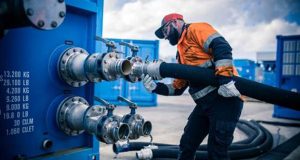 In the hierarchy of risk control, PPE is considered to rank lowest and represents the option of last resort. PPE is only appropriate where the hazard in question cannot be totally removed or adequately controlled by other means (for example by isolating the hazard or reducing the risk at source to an acceptable level).
In the hierarchy of risk control, PPE is considered to rank lowest and represents the option of last resort. PPE is only appropriate where the hazard in question cannot be totally removed or adequately controlled by other means (for example by isolating the hazard or reducing the risk at source to an acceptable level).
Personal protective equipment (PPE) is:
‘all equipment (including clothing affording protection against the weather) which is intended to be worn or held by a person at work and which protects the user against one or more risks to their health or safety.’
Examples include:
- Safety helmets
- Gloves
- Safety boots or other footwear
- Eye protection and face shields
- High-visibility clothing
- Warm and weatherproof clothing
- Safety harnesses or fall arrest systems
- Hearing protection
- Respiratory protective equipment.
When choosing PPE make sure it:
- Is appropriate for the risks and the working environment. For example, eye protection for the avoidance of splashing with agricultural pesticides may not offer adequate face protection when using an angle grinder to cut steel.
- Takes into account the needs of the job and the demands it places on the wearer; such as the length of time it needs to be worn, the physical effort required to do the job and the requirements for visibility and communication.
- Adequately controls the risk presented by the hazard without increasing overall risk experienced by the worker. (eg. Ear-defenders that reduce the level of noise impacting on the worker may make it difficult to hear audible alarms.)
- Takes into account the user’s health, ergonomics, physical and other factors.
- Can be adjusted to fit the wearer correctly.
- Is compatible when more than one item of PPE is being worn. For example, does a particular type of respirator make it difficult for eye protection to be fitted properly?
Recommendations for employers:
- Assess the risks to employee’s health and safety arising from the work activities.
- Organise work activities so that PPE is not necessary, eg introduce engineering controls to remove hazards.
- Where PPE is necessary (because all risks can’t be controlled), select appropriate items that suit the wearer and are made to the required standard.
- Supply employees with the necessary PPE free of charge.
- Train employees to use PPE, and explain any limitations of the equipment.
- Ensure compatibility if more than one item of PPE is worn.
- Ensure that PPE is maintained and inspected.
- Replace defective or lost PPE.
In addition:
- Investigate when PPE is not being used and take appropriate action.
- Ensure safety signs are displayed to users to
wear PPE.
Training on the use of PPE must include:
- The circumstances in which PPE is required and how to use it effectively.
- Awareness of why PPE is needed, when it is to be used, repaired or replaced and its limitations.
- The dangers of working without PPE.
- The procedure for replacing PPE.
LEGAL DUTIES
Under the Personal Protective Equipment at Work Regulations 1992: ‘Every employer shall ensure that suitable personal protective equipment is provided to his employees who may be exposed to a risk to their health or safety while at work except where and to the extent that such risk has been adequately controlled by other means which are equally or more effective’.
The Health and Safety at Work etc. Act 1974 (HSWA) places a general duty of care on employers for ensuring the safety of their employees and others and requires that no charge may be made for providing PPE (section 9).
CASE LAW
The costs of not providing the correct PPE can far outweigh the costs of buying it.
A farmer was prosecuted for failing to provide adequate training in the safe use of All Terrain Vehicles (ATVs) following an accident to an employee. The investigation revealed that the employee had not received any training in the safe operation of ATVs and at the time of the accident was not wearing a safety helmet, although one was available. It also appeared that other employees had operated the ATV without training and without using the PPE provided. A fine of £350 together with £1,006 costs resulted.
Large civil liability claims for injuries arising from a failure to provide appropriate PPE can also be brought against the employer.




